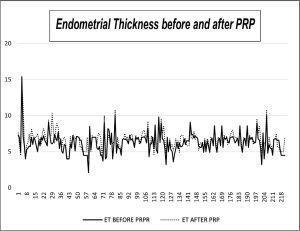
ABSTRACT
Background: Although various groups have reported the effects of intrauterine infusion of platelet-rich plasma, studies evaluating the effectiveness of injecting it hysteroscopically at the endomyometrial junction are limited. The latter has more effects on the angiogenic growth of cells. Platelet-rich plasma contains a high concentration of vascular endometrial growth factors and cytokines which are essential for endometrial proliferation. These are inadequately expressed in a deficient endometrium and are enhanced after its administration. The objective of the study was to assess the effect of subendometrial injection of autologous platelet-rich plasma treatment on endometrial thickness and vascularity on refractive endometrium during frozen embryo transfer. Materials and Methods: Data was collected from 232 women with endometrial thicknesses less than or equal to 7mm. Pre, post endometrial thickness and vascularity were assessed before and after platelet rich plasma administration. Results: Among 232 women, 8 were lost in follow-up. Among 224 women, endometrial thickness increased for 152, was not changed for 35, and decreased for 37. The mean endometrial thickness prior to infusion was 5.9mm which was significantly improved to 6.6mm after platelet-rich plasma infusion. Endometrial vascularity significantly improved for 124 women and decreased for 11 with no improvement observed in 89 women after platelet-rich plasma administration. Conclusion: Subendometrial administration of platelet-rich plasma has effectively improved the thickness and vascularity of endometrium thereby helping in pregnancy outcomes. Further in-depth molecular studies are required to interpret this therapy’s specific mechanism and beneficial role on the endometrium.
